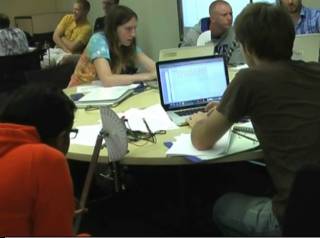You are here: start » activities » main
Pendulum Lab
Highlights of the activity
- This integrated laboratory activity is designed to help upper-division undergraduate students learn to connect a model to an experiment in the case of a plane pendulum.
- Students measure the period of a plane pendulum for small- and large-amplitude oscillations and analyse the data to discover the relationship between period and amplitude.
- The small group discussion focuses on resolving inconsistencies between the data and a model of a plane pendulum as a harmonic oscillator, as well as investigate a more complete model.
Reasons to spend class time on the activity
This is a laboratory exercise that allows students to make their own measurements to investigate a model. Students may have studied the differential equation of motion or they may have calculated the period of oscillation by integrating $\frac{dx}{v(x)}$ (as we do in our course). They might have considered a restoring force linear in angular displacement, or the correct force that varies as sin(theta). They may simply be observing without having considered any model. In any approach, this lab gives the students the opportunity to test and refine their model, or to define the important features that any proposed model should have. The measurements are simple, and students find the mechanical system a useful, “concrete” example to refer to later in the course when oscillations of electrical circuits are studied. The latter seem to be much less “concrete” to many students.
